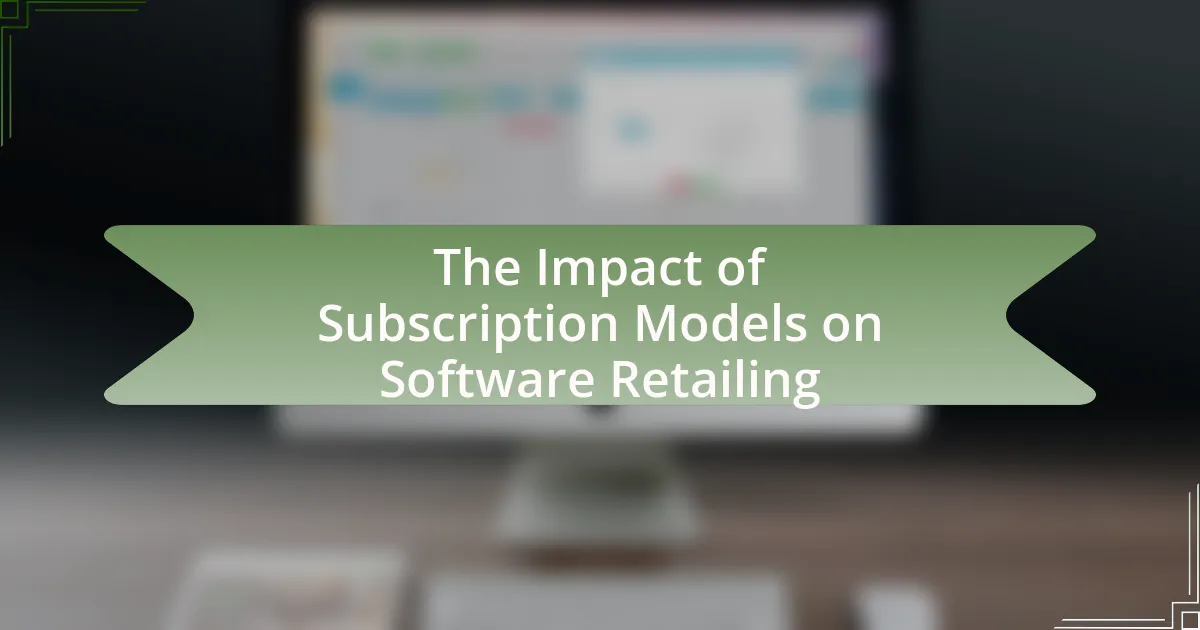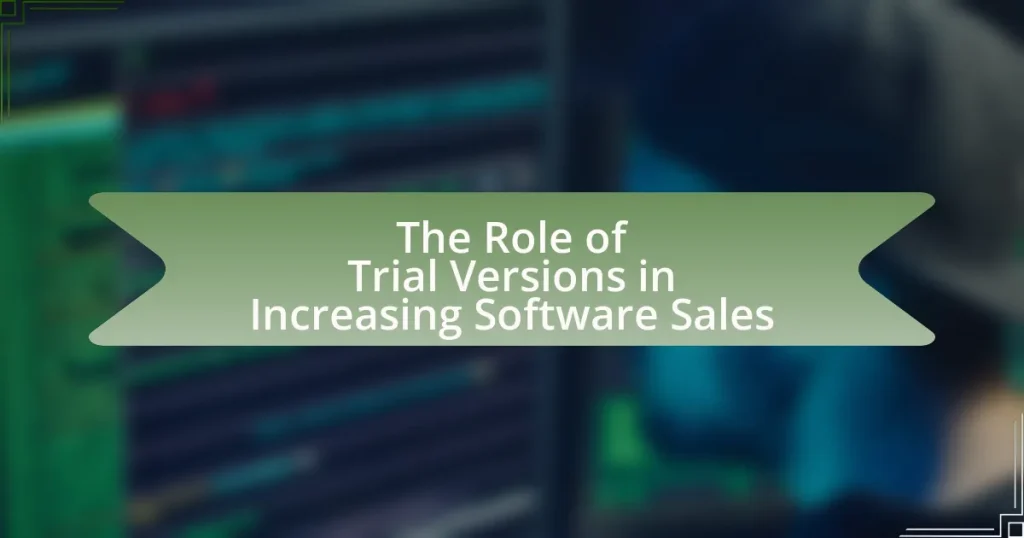The article examines the impact of subscription models on software retailing, highlighting their growing popularity due to benefits such as predictable revenue streams, customer retention, and ongoing access to updates. It contrasts subscription models with traditional software retailing, emphasizing differences in payment structures and user engagement. Key characteristics of subscription models, including tiered pricing and flexibility, are discussed, along with market trends driving their adoption. The article also addresses challenges faced by software retailers, such as customer churn and competition, while outlining best practices for optimizing pricing strategies and enhancing customer engagement.
What are Subscription Models in Software Retailing?
Subscription models in software retailing are pricing strategies where customers pay a recurring fee to access software services or products. This model allows users to benefit from continuous updates, support, and features without the need for a large upfront investment. According to a report by Gartner, subscription-based software revenue is projected to grow significantly, indicating a shift in consumer preference towards this model due to its flexibility and cost-effectiveness.
How do subscription models differ from traditional software retailing?
Subscription models differ from traditional software retailing primarily in their payment structure and access to updates. In subscription models, users pay a recurring fee, typically monthly or annually, which grants them continuous access to the software and regular updates. In contrast, traditional software retailing usually involves a one-time purchase, where users pay upfront for a specific version of the software, often requiring additional fees for future upgrades or support. This difference in payment structure influences user engagement and software lifecycle management, as subscription models encourage ongoing customer relationships and provide developers with a steady revenue stream, which can lead to more frequent updates and improvements.
What are the key characteristics of subscription models?
Subscription models are characterized by recurring payments for access to products or services over a specified period. These models typically offer flexibility in pricing, allowing customers to choose from various plans based on their needs, which can enhance customer retention. Additionally, subscription models often provide continuous updates and support, ensuring that users have access to the latest features and improvements. This approach can lead to predictable revenue streams for businesses, as they can forecast income based on the number of active subscribers. Furthermore, subscription models frequently utilize tiered pricing structures, catering to different customer segments and maximizing market reach.
How do pricing strategies vary between subscription and traditional models?
Pricing strategies differ significantly between subscription and traditional models. Subscription models typically employ a recurring payment structure, allowing customers to access services or products over time, which can lead to increased customer retention and predictable revenue streams. In contrast, traditional models often rely on one-time payments for ownership, which can result in higher upfront costs for consumers and less predictable revenue for businesses.
For example, a software company using a subscription model may charge $10 per month, generating $120 annually per customer, while a traditional model might sell the same software for a one-time fee of $300. This difference in pricing strategy affects cash flow, customer acquisition costs, and long-term profitability, as subscription models can foster ongoing relationships and upselling opportunities.
Why are subscription models gaining popularity in the software industry?
Subscription models are gaining popularity in the software industry primarily due to their ability to provide predictable revenue streams for companies while offering customers flexibility and lower upfront costs. This model allows software providers to maintain continuous engagement with users, facilitating regular updates and improvements, which enhances customer satisfaction and retention. According to a report by Gartner, subscription-based software revenue is projected to grow significantly, indicating a shift in consumer preference towards services that offer ongoing value rather than one-time purchases.
What market trends are driving the shift towards subscription models?
The shift towards subscription models is primarily driven by consumer demand for flexibility and convenience. As consumers increasingly prefer on-demand access to products and services, businesses are adapting by offering subscription options that allow for lower upfront costs and ongoing access. Additionally, the rise of digital platforms has facilitated the delivery of subscription services, making it easier for companies to implement and manage these models. According to a report by McKinsey, subscription services have grown by more than 100% annually over the past five years, indicating a significant market trend towards this model.
How do consumer preferences influence the adoption of subscription models?
Consumer preferences significantly influence the adoption of subscription models by driving demand for flexibility, convenience, and perceived value. As consumers increasingly favor on-demand access to products and services over ownership, subscription models that offer these benefits become more appealing. For instance, a survey by Zuora found that 70% of consumers prefer subscription services for their ability to provide cost savings and convenience, indicating a strong preference for models that align with their lifestyle choices. This shift in consumer behavior towards valuing experiences and access over ownership directly correlates with the rise of subscription-based offerings in software retailing, as companies adapt to meet these evolving preferences.
What are the impacts of subscription models on software retailers?
Subscription models significantly impact software retailers by providing a steady revenue stream and enhancing customer retention. These models shift the focus from one-time sales to ongoing relationships, allowing retailers to predict cash flow more accurately. According to a study by McKinsey, companies that adopt subscription models can experience revenue growth rates of 5 to 10 times faster than traditional software sales. Additionally, subscription models often lead to increased customer engagement, as users are more likely to utilize and renew services when they are paying regularly. This engagement can result in higher customer lifetime value, as seen in companies like Adobe, which transitioned to a subscription-based model and reported a 20% increase in annual recurring revenue.
How do subscription models affect revenue streams for software companies?
Subscription models significantly enhance revenue streams for software companies by providing a consistent and predictable income flow. This model allows companies to generate recurring revenue, which can lead to improved cash flow and financial stability. According to a study by the SaaS Capital, companies utilizing subscription models can achieve a 5-10 times higher valuation compared to traditional software sales models due to the predictable nature of their revenue. Additionally, subscription models often result in higher customer lifetime value, as they encourage long-term customer relationships and reduce churn rates. This shift from one-time purchases to ongoing subscriptions has transformed the financial landscape for software companies, enabling them to invest more in product development and customer support.
What are the implications of recurring revenue on financial stability?
Recurring revenue significantly enhances financial stability by providing predictable cash flow and reducing revenue volatility. This predictability allows businesses to better manage expenses, plan for growth, and invest in long-term projects. According to a study by SaaS Capital, companies with recurring revenue models experience a 30% higher valuation compared to those relying on one-time sales, demonstrating the financial advantages of stable income streams. Additionally, recurring revenue fosters customer loyalty, leading to higher retention rates, which further stabilizes revenue over time.
How does customer retention change with subscription models?
Customer retention typically increases with subscription models due to their inherent structure that fosters ongoing engagement. Subscription models create a continuous relationship between the customer and the service provider, which encourages loyalty and reduces churn rates. For instance, research by Zuora indicates that companies utilizing subscription models experience a 5-10% higher retention rate compared to traditional sales models. This is largely because subscriptions often include regular updates, customer support, and community engagement, which enhance the overall customer experience and satisfaction.
What challenges do software retailers face with subscription models?
Software retailers face several challenges with subscription models, including customer retention, revenue predictability, and competition. Customer retention is critical, as subscription models require ongoing engagement to prevent churn; research indicates that acquiring a new customer can cost five times more than retaining an existing one. Revenue predictability is another challenge, as fluctuating subscription rates can complicate financial forecasting and cash flow management. Additionally, competition has intensified, with numerous companies offering similar subscription services, making it difficult for retailers to differentiate their offerings and maintain market share.
How do subscription models impact customer acquisition costs?
Subscription models generally reduce customer acquisition costs by providing predictable revenue streams and enhancing customer retention. This model allows businesses to invest more in marketing and customer engagement strategies, which can lead to lower costs per acquisition over time. For instance, a study by McKinsey & Company found that subscription-based companies can achieve customer acquisition costs that are 30% lower than traditional sales models due to the ongoing relationship with customers, which fosters loyalty and reduces churn. Additionally, subscription models often leverage word-of-mouth and referral programs, further decreasing the need for expensive advertising.
What are the risks associated with churn in subscription-based businesses?
Churn in subscription-based businesses poses significant risks, including revenue loss, increased customer acquisition costs, and damage to brand reputation. When customers cancel their subscriptions, businesses experience immediate revenue decline, which can disrupt cash flow and hinder growth. Additionally, acquiring new customers often costs five to seven times more than retaining existing ones, leading to higher marketing expenses as companies strive to replace lost subscribers. Furthermore, high churn rates can negatively impact brand perception, as potential customers may view a business with many cancellations as unreliable or untrustworthy. According to a study by the Harvard Business Review, a 5% increase in customer retention can lead to a 25% to 95% increase in profits, highlighting the critical importance of managing churn effectively.
How do subscription models influence consumer behavior?
Subscription models significantly influence consumer behavior by promoting a sense of commitment and reducing the perceived risk associated with purchases. Consumers are more likely to engage with products or services when they can access them for a lower upfront cost, which subscription models typically offer. This model encourages ongoing usage and loyalty, as evidenced by a study from Zuora, which found that subscription-based businesses grow revenue 5 times faster than traditional businesses. Additionally, the convenience of automatic renewals and the ability to try products without a long-term commitment lead to increased consumer satisfaction and retention.
What are the benefits of subscription models for consumers?
Subscription models offer consumers several benefits, including cost savings, convenience, and access to a wider range of products. Consumers often pay lower upfront costs compared to traditional purchasing methods, allowing them to access software without significant financial commitment. For example, a subscription to a software service can cost as little as $10 per month, while a one-time purchase may exceed $100. Additionally, subscription models provide continuous updates and support, ensuring consumers always have the latest features and security enhancements. This model also allows consumers to try out software before fully committing, reducing the risk of buyer’s remorse. Overall, these benefits make subscription models an attractive option for consumers in the software retailing space.
How do subscription models enhance user experience and accessibility?
Subscription models enhance user experience and accessibility by providing users with continuous access to software and services without the need for large upfront payments. This model allows users to pay smaller, manageable amounts over time, making high-quality software more affordable and accessible to a broader audience. For instance, according to a 2021 report by Statista, the global subscription software market is projected to reach $1 trillion by 2025, indicating a growing trend towards this model that caters to diverse user needs. Additionally, subscription services often include regular updates and customer support, which further improves user satisfaction and engagement.
What role does flexibility play in consumer satisfaction with subscriptions?
Flexibility significantly enhances consumer satisfaction with subscriptions by allowing users to tailor their experiences to meet individual needs. When subscription services offer options such as customizable plans, easy cancellation, and the ability to pause or modify subscriptions, consumers feel more in control and valued. Research indicates that 70% of consumers prefer subscription services that provide flexible terms, as this adaptability leads to higher retention rates and positive user experiences. This correlation between flexibility and satisfaction is evident in various subscription-based industries, where companies that prioritize consumer preferences often see increased loyalty and reduced churn.
What are the potential downsides for consumers using subscription models?
The potential downsides for consumers using subscription models include ongoing costs, lack of ownership, and potential service discontinuation. Ongoing costs can accumulate over time, leading to higher total expenses compared to one-time purchases; for instance, a software subscription costing $10 monthly results in $120 annually, which may exceed the price of a perpetual license. Lack of ownership means consumers do not possess the software outright, limiting their ability to use it indefinitely; if a subscription is canceled, access to the software is lost. Additionally, service discontinuation can occur if a provider decides to shut down or alter their offerings, leaving consumers without access to previously used tools. These factors can significantly impact consumer satisfaction and financial planning.
How can hidden costs affect consumer perceptions of value?
Hidden costs can significantly diminish consumer perceptions of value by creating a sense of mistrust and dissatisfaction. When consumers encounter unexpected fees or charges, they often feel misled, which can lead to negative evaluations of the overall product or service. Research indicates that 70% of consumers are more likely to abandon a purchase if they discover hidden costs during the checkout process, highlighting the critical impact of transparency on perceived value. This perception is particularly relevant in subscription models, where ongoing costs can accumulate, further exacerbating feelings of being deceived if not clearly communicated upfront.
What are the implications of long-term commitments in subscription services?
Long-term commitments in subscription services can lead to increased customer loyalty and predictable revenue streams for businesses. These commitments often result in customers feeling more invested in the service, which can enhance retention rates; for example, a study by Zuora found that companies with subscription models experience a 5-10% higher retention rate compared to traditional sales models. Additionally, long-term subscriptions can provide businesses with a steady cash flow, allowing for better financial planning and resource allocation. However, they also pose risks, such as potential customer dissatisfaction if the service does not meet expectations over time, which can lead to higher churn rates if customers decide to cancel after the commitment period.
What best practices should software retailers consider when implementing subscription models?
Software retailers should prioritize customer experience and flexibility when implementing subscription models. This involves offering tiered pricing plans that cater to different user needs, ensuring that customers can easily upgrade or downgrade their subscriptions based on their requirements. Additionally, retailers should focus on providing clear communication regarding billing cycles, cancellation policies, and the value proposition of their services. Research indicates that 70% of consumers prefer subscription services that allow for easy management of their accounts, highlighting the importance of user-friendly interfaces and customer support. Furthermore, retailers should leverage data analytics to understand customer behavior and preferences, enabling them to tailor offerings and improve retention rates.
How can software retailers optimize pricing strategies for subscriptions?
Software retailers can optimize pricing strategies for subscriptions by employing data-driven pricing models that analyze customer behavior and market trends. Utilizing analytics tools allows retailers to segment their customer base, identify willingness to pay, and tailor pricing tiers accordingly. For instance, a study by McKinsey & Company found that companies using advanced analytics for pricing can increase profits by 2-7%. Additionally, implementing dynamic pricing strategies that adjust based on demand and competition can further enhance profitability. Retailers should also consider offering flexible subscription plans, such as monthly or annual options, to cater to diverse customer preferences, thereby increasing customer retention and acquisition.
What strategies can enhance customer engagement and reduce churn?
Implementing personalized communication strategies enhances customer engagement and reduces churn. Personalized emails, tailored recommendations, and targeted promotions based on user behavior significantly increase customer satisfaction and loyalty. Research indicates that companies utilizing personalized marketing see a 20% increase in sales (McKinsey & Company). Additionally, providing exceptional customer support through multiple channels, such as live chat and social media, fosters a sense of community and trust, further decreasing churn rates. A study by Zendesk found that 67% of customers prefer self-service options, highlighting the importance of accessible support. Regularly soliciting feedback and acting on it also strengthens customer relationships, as 70% of customers feel more valued when their opinions are considered (Salesforce).



